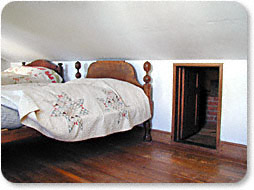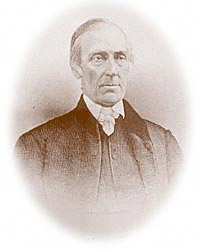 One Click...
One Click...
to all things local!
A part of the legendary Underground Railroad for fleeing slaves of pre-Civil War days, this registered National Historic Landmark is a Federal style brick home built in 1839.
 Escaping slaves could be hidden in this small upstairs room and the beds moved in front of the door to hide its existence. |
Levi and Catharine Coffin were legendary in helping many former slaves escape to freedom in the North. Levi is often referred to as the President of the Underground Railroad.
Life for a runaway slave was full of hazards. The journey to freedom meant traveling only a few miles at night, using the North Star as a map and trying to avoid search parties. Often, escaped slaves would hide in homes or on the property of antislavery supporters. These stops to freedom were called Underground Railroad stations because they resembled stops a train would make between destinations. "Underground" refers the the secret nature of the system.
To the thousand of escaped slaves, an eight-room Federal style brick home
in Newport (Fountain City), Indiana, became a safe haven on their journey to Canada.  This was the home of
This was the home of
 Escaping slaves were well hidden for their travels in this wagon when grain bags were piled around the hiding area. |
In their flight, slaves used three main routes to cross into freedom: Madison and Jeffersonville, Indiana and Cincinnati, Ohio. From these points, the fugitives were taken to Newport.  Once in the house, the presence of the runaway slaves could be concealed for up to several weeks, until they gained enough strength to continue their journey.
Once in the house, the presence of the runaway slaves could be concealed for up to several weeks, until they gained enough strength to continue their journey.
So successful was the Coffin sanctuary that, while in Newport, not a single slave failed to reach freedom. One of the many slaves who hid in the Coffin home was "Eliza", whose story is told in Uncle Tom's Cabin. In 1847, the Coffins moved to Cincinnati so that Levi could operate a wholesale warehouse which supplied goods to free labor stores.
The Coffin house was purchased in 1967 by the State of Indiana. The house was restored and then opened to the public in 1970. The site is a registered National Historic Landmark. Prior to 2016 the home was operated by the Levi Coffin House Association. In 2016, an Interpretive Center was built and the Indiana State Historic Site is now operated by the Indiana State Museum.
 Levi Coffin |
 Catharine Coffin |
Recommended Links
Levi Coffin House
![]() The Levi Coffin House has been included on the list of the top 25 history sites in the nation by The History Channel!
The Levi Coffin House has been included on the list of the top 25 history sites in the nation by The History Channel!
![]() The Smithsonian names the Levi Coffin House Interpretive Center as one of twelve new museums around the world to visit in 2016!
The Smithsonian names the Levi Coffin House Interpretive Center as one of twelve new museums around the world to visit in 2016!
 View More Photos (Page 1 | Page 2 | Flickr Set)
View More Photos (Page 1 | Page 2 | Flickr Set)- Lessons Plans for Grades K-12
- Your Levi Coffin House Tour meets Indiana Academic Standards for many classes.
- Indiana State Museum State Historic Site: Levi Coffin State Historic Site
- Levi Coffin House: Aboard the Underground Railroad - a national register travel itinerary.
- 4th Graders Leave Their Mark at Levi Coffin House - Young people connect with history, a Palladium-Item Newspaper article.
- Levi Coffin House Architectural Prints - Library of Congress
- Historical Marker
- Story of the Levi Coffin Home - by the Indiana Department of Natural Resources
- Stories from the Road to Freedom, a DVD set, available for purchase from The History Channel. The Levi Coffin House is featured in Secret Passages, Episode 11.
- Video - short introduction by volunteer, Janice McQuire
Levi and Catharine Coffin
- Excerpt from Reminiscences of Levi Coffin - Levi's own words tell you about the experience of running a station on the Underground Railroad.
- Levi Coffin Biography - by the African-American Registry
- Levi and Catharine Coffin - by the Indiana Historical Society
- Letters from Levi Coffin to William Still in Maryland
- Reminiscences of Levi Coffin - Published in 1876 - full-text provided by MOA (Making of America - Digital Library), University of Michigan
- Manumission papers that were witnessed by Levi Coffin - these are legal documents showing the purchase of slaves by Quakers who would then care for them until they could be transported into a free state. Be sure to review the comments that describe the significance of these documents.
- Handwritten Will of Levi Coffin, located at the University of Cincinnati
Underground Railroad in Indiana
- Follow the North Star - learn about this unique "first-person" program at Conner Prairie in Fishers, Indiana to teach students ages 12 and up about the Underground Railroad.
- Indiana's Freedom Trails
- Indiana Historical Bureau: Underground Railroad: Publications, Historical Markers, Research and additional links.
- Quakers(Society of Friends) in Richmond and Wayne County - learn about the beliefs of the Quakers, local Quaker history, and see local Quaker points of interest.
- The Underground Railroad in Indiana
- Underground Railroad Indiana!
- Underground Railroad - educational programs by the Indiana DNR
- Underground Railroad Sites in Wayne County, Indiana - Indiana DNR, Div. of Historic Preservation and Archaeology
Underground Railroad in Ohio and the Midwest
- Kentucky's Underground Railroad - includes a brief history of slavery in Kentucky.
- National Underground Railroad Freedom Center
- Ohio River National Freedom Corrior
- Underground Railroad - by the Ohio Historical Society
- Underground Railroad in Ohio
- Wilbur H. Seibert Collection (The Underground Railroad Research of Ohio State University, Professor Wilbur H. Siebert)
Underground Railroad: General Information
- The Underground Railroad from Slavery to Freedom - by Wilbur Henry Siebert, Albert Bushnell Hart
- Aboard the Underground Railroad - a national register travel itinerary.
- Discover Underground Railroad History - by the National Park Service
- R.I.D.E. the Underground Railroad
- History of the Underground Railroad: A Timeline
- Interactive Game: The Underground Railroad in the Ohio River Valley
- The Underground Railroad: Escape from Slavery - by Scholastic, includes teacher's guide.
- Interactive Map of Underground Railroad Sites
- Map - Underground Railroad routes, as drawn by Wilbur H. Seibert
- Map - Underground Railroad routes by the National Park Service
- Pathways to Freedom: Maryland and the Underground Railroad
- Sydney Howard Day's "Record of Fugitives" - hosted by the Columia University Libraries
- Network to Freedom - by the National Park Service
- The Underground Railroad - by National Geographic, an excellent site that gives a visitor the feeling of traveling along the Underground Railroad.
- The Underground Railroad - by PBS, part of their Africans in America series.
- Tracks to Freedom - follow along with reporter Chris Lackner as he travels by foot from Mays Lick, Kentucky, to North Buxton, Ontario, in search of the history of the Underground Railroad and its connections to Canada.
- Underground Railroad Bike Route
Locate the Levi Coffin House
View Levi Coffin House in a larger map
![]()
![]()
![]()
![]()
Location
Levi and Catharine Coffin State Historic Site
201 U.S. 27 North
P.O. Box 26
Fountain City, IN 47341
Map
Admission
$10.00/Adult
$8.00/Senior
$5.00/Child
Free! - Indiana students, as part of a pre-arranged school field trip
Hours
Wednesday - Sunday
10:00 a.m. to 5:00 p.m.
Closed Monday, Tuesday, Easter, Thanksgiving and Christmas Eve and Christmas Day
If you plan on visiting the site during the months school is in session, Wednesday through Friday, please call ahead. Due to a number of school group visits, guided tours of the Coffin home may be limited. Please call ahead to find out if your visit may be impacted.
Contact
765.847.1691 Museum
Email: LeviCoffinCenter@indianamuseum.org
Joanna E. Hahn, Site Manager
|
This jQuery slider was created with the free EasyRotator software from DWUser.com.
Need a powerful Flash slideshow creator with built-in iPhone/iPad/Android support? EasyRotator is supported by the XML Flash Slideshow v4 Software. OK |
This jQuery slider was created with the free EasyRotator software from DWUser.com.
Need a powerful Flash slideshow creator with built-in iPhone/iPad/Android support? EasyRotator is supported by the XML Flash Slideshow v4 Software. OK |
|
This jQuery slider was created with the free EasyRotator software from DWUser.com.
Use WordPress? The free EasyRotator for WordPress plugin lets you create beautiful WordPress sliders in seconds. OK |
This jQuery slider was created with the free EasyRotator software from DWUser.com.
Use WordPress? The free EasyRotator for WordPress plugin lets you create beautiful WordPress sliders in seconds. OK |
Featured Member
Did You Know?
Wayne County Fast Facts
| Location: | East Central Indiana, USA |
| Founded: | 1810 |
| Population: | 66,456 |
| Elevation: | 1,257 feet Highest Point in Indiana |
| County Seat: | Richmond |
| Local Time: | |
| Date: | |
| About Indiana: | IN.gov |
| Current Weather: |
Follow Us
Contact Us
| Email: | info@waynet.org |
| Phone: | 765.939.0857 |
| Mail: | 50 North 5th St. Richmond, IN 47374 |
| Director: | Board of Directors |
Stay in Touch
Sign up for WayNet News
- our e-newsletter.
Translate This Page
Join WayNet
About WayNet
Waynet, Inc. is a non-profit, 501(c)4 corporation that is fully-funded through memberships. Please support our members and let them know you located them via WayNet.org.
Top 25: popular pages & circulation information.
Our Recent Tweets
Copyright © Waynet, Inc. 2022, All Rights Reserved.| Policies
Directory | News | Discover | Find It Fast | Knowledge | To Do | Members


























